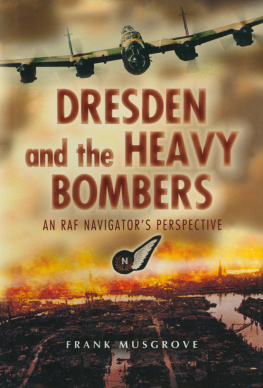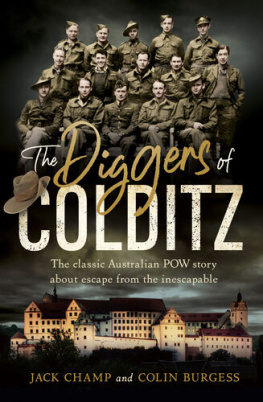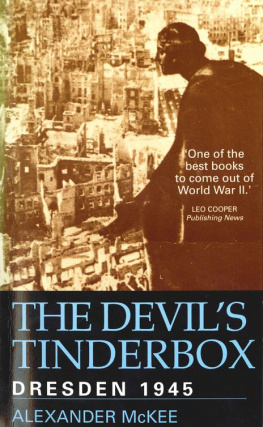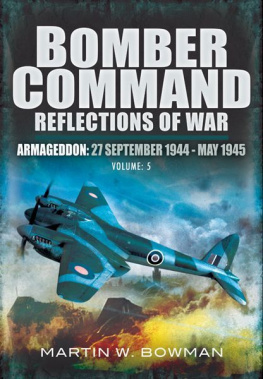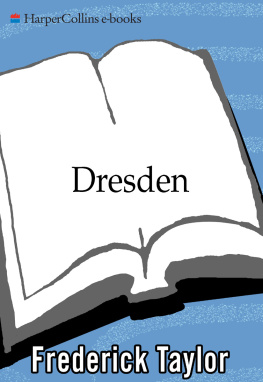DRESDEN
AND THE
HEAVY BOMBERS
DRESDEN
AND THE
HEAVY BOMBERS
An RAF Navigators Perspective
Frank Musgrove
First published in Great Britain in 2005 by
Pen & Sword Aviation
an imprint of
Pen & Sword Books Ltd
Copyright Frank Musgrove, 2005
ISBN 1 84415 194 8
The right of Frank Musgrove to be identified as Author of this Work has
been asserted by him in accordance with the Copyright, Designs and
Patents Act 1988.
British Library Cataloguing-in-Publication Data
A CIP catalogue record for this book is
available from the British Library
All rights reserved. No part of this book may be reproduced or transmitted in
any form or by any means, electronic or mechanical including photocopying,
recording or by any information storage and retrieval system, without
permission from the Publisher in writing.
Typeset in 10/12pt Palatino by
Phoenix Typesetting, Auldgirth, Dumfriesshire
Printed and bound in England by
CPI UK
Pen & Sword Books Ltd incorporates the Imprints of Pen & Sword Aviation,
Pen & Sword Maritime, Pen & Sword Military, Wharncliffe Local History,
Pen & Sword Select, Pen & Sword Military Classics and Leo Cooper.
For a complete list of Pen & Sword titles please contact
PEN & SWORD BOOKS LIMITED
47 Church Street, Barnsley, South Yorkshire, S70 2AS, England
E-mail: enquiries@pen-and-sword.co.uk
Website: www.pen-and-sword.co.uk
Acknowledgement
I am greatly indebted to Dr Peter Liddle, Director of the Second World War Experience Centre, Leeds, to whom I first sent this memoir for deposit in the Centres archive. Dr Liddle suggested that it might interest a wider readership and advised me on the possibilities of publication. I am very grateful for this help.
Frank Musgrove
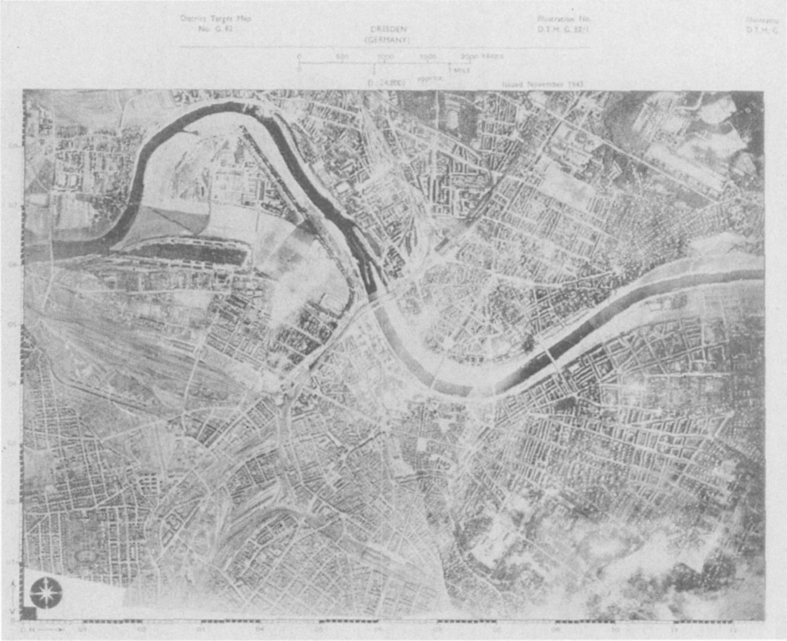
The Dresden Target Map
Contents
Prologue:
Destructiveness
T his is a story that chronicles a young mans entry into war in 1941 and culminates in his flying (as a Lancaster navigator) on the bombing raid to Dresden in February 1945. It offers a view from the astrodome as the bombers war was seen in close-up at the time, and broader perspectives from sixty years on.
This is not a gung-ho, press-on-regardless. Boys Own Paper account of my experience of flying with RAF Bomber Command; but neither is it an exercise in hand-wringing nor breast-beating and avowals of guilt. There is a basic narrative that follows my volunteering for flying duties in the Second World War and eventual membership of a front-line heavy bomber squadron in 1944; it pays particular attention to fear and morale and the myth of leadership. Half a dozen bombing missions are described in some detail, illustrating the variety of experience, problems and dangers involved.
This is a memoir about learning a highly skilled trade (as an air navigator before computers) and applying the basic principles under various conditions and methods of war from the area bombing of Cologne and Dortmund to G-H precision bombing of ball-bearing factories at Solingen, Homberg and Witten. I hope that a reader with little or no technical knowledge will feel that he was actually there and could have done the navigation himself.
A memoir which includes the bombing of factories and cities inevitably raises grave moral issues, which I have also tried to address. I did not feel them very strongly at the time, but they have crept up on me slowly, insidiously, over the past sixty years. Dresden has been invested with huge symbolic significance; and a number of well-publicised books have highlighted its awfulness. Kurt Vonneguts personal witness account in Slaughterhouse Five (1970) and Alexander McKees The Devils Tinderbox (1982) made a strong impression on me; but David Irvings The Destruction of Dresden (1963) seemed grossly overstated. The number of civilian deaths was certainly much smaller than the 135,000 that he estimated. Nevertheless, the probable number, somewhere between 25,000 and 60,000, was certainly grievous (61,000 is the number of British civilians killed by the Luftwaffes bombs in the entire course of the war).
I have wondered why this was a war of unparalleled destructiveness of people, of property, of values and of institutions. Of course, there were now technical means to be massively destructive, but unconditional surrender as an Allied war aim must carry a large part of the blame. Unconditional surrender leads inexorably to the prolongation of war and to its utter destructiveness: there is no incentive for the side that is clearly losing to sue for peace and the leadership will almost certainly hang. In an age of different and perhaps more chivalric values and priorities. Napoleon in defeat was given a miniature kingdom, a handsome pension and a bodyguard of 400 officers and men. It is true that in 1919 there were cries of Hang the Kaiser, but he had taken comfortable retirement in Holland and no-one knew how to extract him or how to hang him if they did.
Unconditional surrender was an American import, first given currency by ex-President Theodore Roosevelt in New Yorks Carnegie Hall in July 1918, and announced (without consultation) by President F.D. Roosevelt to newsmen at the Casablanca Conference in February 1943. Churchill had serious misgivings but to his shame acquiesced. This requirement cut right across European traditions and customs of war.
It is true we required regime change after defeating France in 181415 and Germany in 1918, but we did not otherwise impose non-negotiable terms. The defeated nation had recognised representation and an important voice in the final settlement more so in 181415 than in 1918, by which time a distinct hardening of attitude had occurred. The regime change in France in 1814 the restoration of the Bourbons was carried out with due sensitivity and engineered by Talleyrand, an aristocratic renegade priest who had actually been one of Napoleons ministers. (Wellington had recommended this change after sounding out opinion when he reached Toulouse and Bordeaux after his triumph in Spain.) France retained her historic frontiers (as they existed in 1792) and indeed most of her colonial possessions. For twenty-five years France had been a threat to the peace and order of Europe. After revolution at home and the encouragement of subversion abroad came the Terror and then the Corsican Ogre who overran Europe and reached the gates of Moscow. By present-day-standards France was treated with astonishing understanding and, indeed, generosity. There was, however, a very careful and elaborate rebalancing of power within Europe designed principally to deter France from future aggression. These arrangements worked remarkably well for the next forty years.
In 1918 regime change in Germany was demanded more prescriptively and peremptorily: it had to be something that President Woodrow Wilson could recognise as democracy as understood by Americans. When the German high command seemed reluctant to abandon rule by monarchical autocrats, Wilson threatened that he would not proceed to a negotiated peace settlement but would accept only (unconditional) surrender.
In fact, movement towards a negotiated peace had been active among the European powers at least since early 1917. Count Albert von Mensdorff-Pouilly, Austro-Hungarian ambassador to London before the war, was in Geneva in December with instructions from his Foreign Minister to discuss possible peace terms with General Jan Smuts, a member of the British War Cabinet. Mensdorff-Pouilly could see no reason why the war should continue: it was precipitating the demise of Europe and the passing of economic and financial power to America. He could not see the possibility of Austrias breaking with Germany, but his exact words were reported by Smuts to the War Cabinet: If another year of this destruction has to pass, the position of Europe and civilisation, already so pitiable, would be beyond repair.

